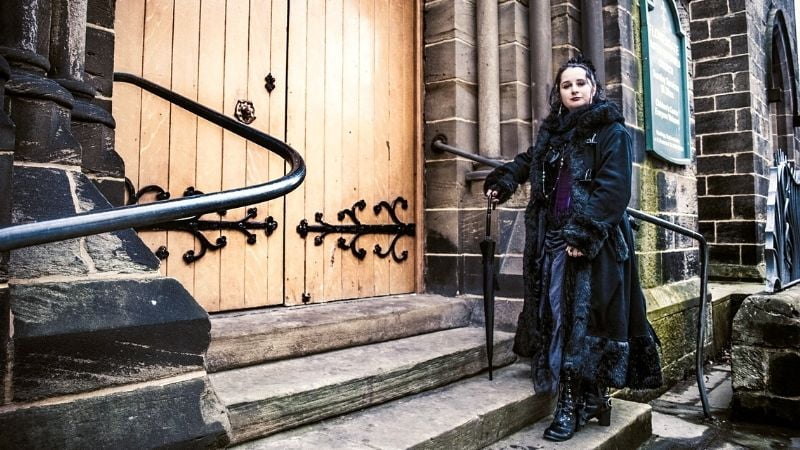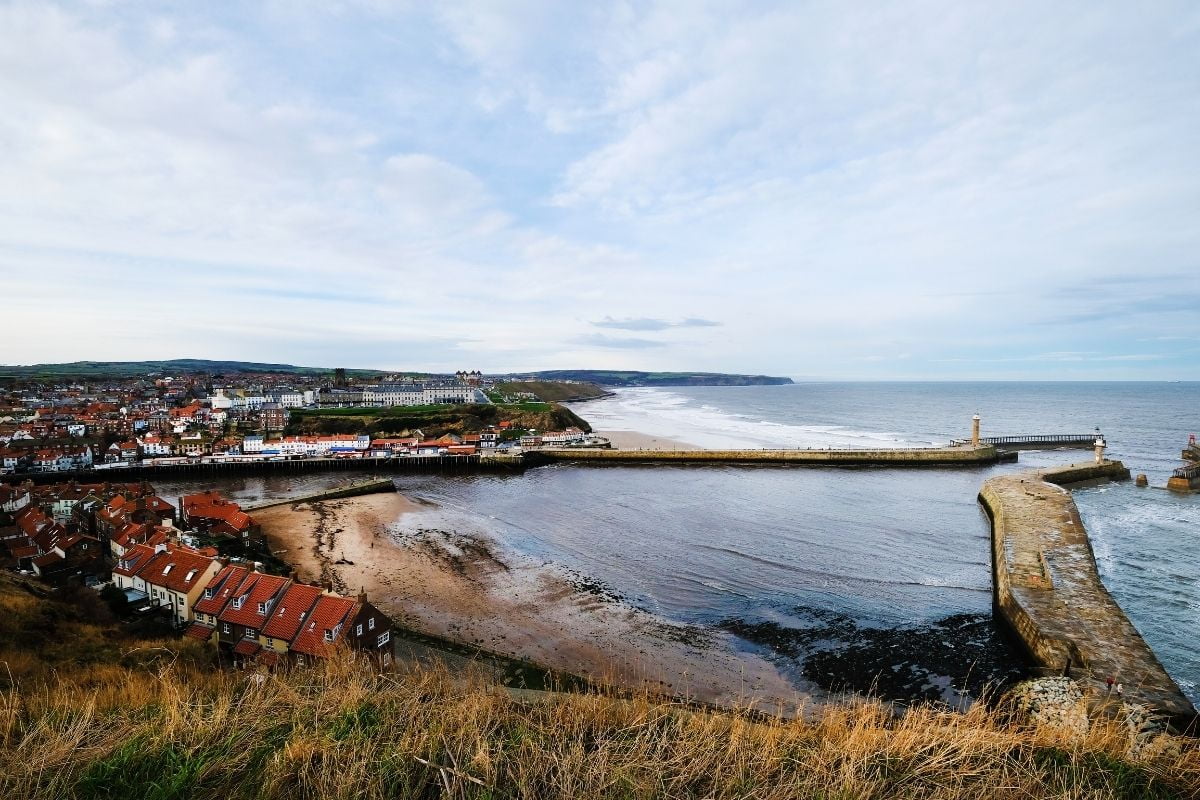What is Whitby famous for? and why do you visit Whitby? What is so captivating about Whitby that has visitors returning over and over again. Here are 17 reasons why Whitby is famous.
Is it the fish and chips? Or just being a pretty little seaside town on the Yorkshire coast?
Locals to the area have so many interesting stories to tell, and if you take the time to listen to the fishermen’s tales and the amateur historians you’ll find that Whitby is associated with several industries, events and people that really put it on the map.
FREE Whitby Mini-Guide
"Get the best from your stay in Whitby." - Everything you need to know about Whitby into a free mini-guide!
1. The Fishing Industry

The fishing industry in Whitby is one of the oldest in the country and is still thriving today!
Fishermen and their boats are recorded in historical archives dating back to the early 1500s when the fishing community was reported to be about 200 strong (a large proportion of the population at the time).
Over the centuries the industry has remained a major source of income for the coastal town, and even though many of the supermarkets now source their seafood from abroad, several large manufacturers and most of the local eateries still rely on the daily supply of Whitby-caught seafood…especially the jumbo scampi!
2. Of course…Fish and Chips!

Located along Whitby’s stunning harbour is the famous Magpie Café which has fresh seafood delivered directly from the boat to the table within 24 hours.
Everyone has their go-to favourite place for fish and chips in Whitby though, whether that be Mr Chips, Silver Street Fisheries, Trenchers, or Quayside!
It’s quite the discussion but the most important thing you can’t deny is how amazing the fish and chips in Whitby is.
3. Restaurants

Whether you’re looking for a seafood feast or fish and chips in the paper on the pier. Whitby has a traditional coastal food to satisfy your hunger.
Whitby is blessed to have flavours from around the world; Italian, Indian, Thai, Chinese, British, home-cooked, seafood, Tapas, Full English.
There is a fantastic selection of restaurants in Whitby, take a look at our Whitby restaurant guide here.
4. Pubs

No visit to Whitby would be complete without a visit to one of the many traditional watering holes used by sailors, smugglers, and sports fans for generations.
Whitby has a wide selection of real ale pubs, dog-friendly pubs, and pubs with accommodation.
From traditional Fisherman’s inns to modern sports bars, Whitby has a pub for everyone! Take a look at our detailed Whitby Pubs guide.
5. Whaling

From 1753 through to 1837 Whitby was known for its highly successful whaling industry. Initially having the use of only two whaling ships, the Whitby Whaling Company left on their first expedition to Greenland with nothing more than a bunch of amateur local fishermen and plenty of goodwill.
Surprisingly the crews saw great success and by 1833 the industry had reached its peak with more than 55 whaling ships working from the harbour.
It is reported that during the lifetime of the whaling industry in Whitby the ships bought home a staggering 25,000 seals, 55 polar bears and 2760 whales!
The whaling industry in the area seemed to collapse as quickly as it had grown and in 1837 it was completely abandoned. The last whaling ship to ever return home to Whitby is said to have returned empty.
6. Whale Watching

Not many people know that the North Sea, just off Whitby, boasts such a rich variety of sea life below the surface.
During late Summer and Autumn vast shoals of herring migrate to the inshore waters off the Yorkshire coast to spawn. The herring attract cetaceans, sharks, birds and seals to feed.
Over the past few years, the whale watching trips onboard the Specksioneer, Summer Queen and Esk Belle III have spotted Minke, Fin, Sei and Humpback Whales, white-beaked and bottlenose dolphins, porpoise as well as thousands of seals!
7. Captain Cook and the HMS Bark Endeavour

Captain James Cook was born in 1728 in Marton, Yorkshire, but became an inhabitant of Whitby at the age of 18 when he was apprenticed to local ship owners of the time, John and Henry Walker.
Over the course of his three-year apprenticeship, Cook worked on trade ships but by 1755 he was ready to serve in the Royal Navy.
During his time in the Navy Captain Cook made three major voyages, the first in his iconic ship HMS Bark Endeavour and the final two using HMS Resolution. Both of these ships were built by Thomas Fishburn in the shipyards of Whitby and originally were used as coal transporters.
The Endeavour was first launched in 1764 but was bought just 4 years later by the Royal Navy specifically for Cook’s voyage to Tahiti. The Resolution was built in 1770 and did just a year as a transporter ship before again being snapped up by the Navy. They obviously knew quality shipbuilding when they saw it.
The Captain Cook Memorial Museum is located in the house once owned by John and Henry Walker (Grape Lane, Whitby); the brothers credited with launching James Cook’s maritime career.
8. Whitby Jet

Whitby Jet is a stunning semi-precious stone that has been used in the manufacture of fine jewellery since the Victorian age. The jewellery makers of the town still craft the stone into a range of exquisite items, although the experts in this trade are becoming few and far between.
Whitby Jet can only be found along a 7 mile stretch of North Yorkshire coastline and is described as amongst the best quality jet available in the UK.
Unfortunately, it’s incredibly hard to mine the stone straight out of a cliff face so the pieces of Whitby Jet used to create individual items of jewellery needs to be foraged for along the numerous stretches of beach. Hence, each item of Whitby Jet jewellery is seen as a prized possession.
9. 199 Steps

The 199 steps, known as the Church Stairs, lead from the Old Town up to St. Mary’s Churchyard. 1340 is the first known record of the 199 steps, however, it is believed the steps were actually made a long time before this.
Believe it or not, the steps were actually originally made of wood and stood for hundreds of years that way until 1774 when the steps were replaced with Sneaton Stone.
Some historians believe that St Hilda would use the steps as a test to confirm the faith of her followers. This was a test of Christian faith to those who wished to worship in St Mary’s Church.
Despite their name, there is actually a lot of controversy over whether there is actually 199 Steps! Next time you’re there you’ll have to give them a count.
10. Whitby Abbey

The view of Whitby Abbey high upon the East Cliff has become one of the iconic landscapes of Yorkshire, known throughout the world and photographed regularly by photographers and visitors.
The founding of Whitby Abbey was a tribute of thanksgiving to God by King Oswui of Northumbria after defeating the Penda, the pagan King of Mercia.
Royal Princess Hild founded the ‘double monastery’ in the Anglo-Saxon style to be used by both men and women. The Abbey became a centre of learning, a renowned nunnery and burial place for the royal family of Deira.
It is through the contribution of Caedmon who is remembered at the Abbey and St Mary’s Churchyard with a cross, that Whitby lays claim to a literary first. Caedmon was the first English poet and Whitby the birthplace of English literature.
The first Synod of Whitby took place to establish the date of Easter. The story goes that in a toss-up between the Ionan practice followed by Irish monks and the Roman tradition favoured by Rome, the decision was settled by Oswui. King Oswui asked both sides if they agreed that St Peter had been handed the keys to the kingdom of Heaven by Christ and pronounced as ‘the rock’ on which the church would be built. Reasoning that St Peter was the highest authority in the Church it was conceded that the Roman tradition is kept. Easter was fixed to be held on a Sunday, the day of Resurrection.
11. Dracula

Everybody has heard of Dracula but unless you have actually read the novel (or seen the film) you may not know that Bram Stoker, the author, set the story in Whitby.
Stoker was sent to Whitby by his doctor as a ‘treatment’ for stress and while out walking in the West Cliff area he is reported to have got the idea for his famous novel.
From the West Cliff, you can see across the harbour to Whitby Abbey, the sands below and the 199 Steps that lead from one to the other.
This sight sets the scene for the opening chapters of the Dracula novel, with Dracula coming ashore from his shipwrecked vessel just below the Abbey. The fact that Bram Stoker chose to have Dracula take on the guise of a large black dog is also a product of his time in Whitby; an idea given to him when listening to the fishermen retelling local legends.
Over the years the novel has become a classic and as a result of its connection to Whitby, the town is now the venue for the world-famous Goth Festival Weekend.
12. Literature

Beyond Bram Stoker, there are literary figures that deserve special mention. Stories about Whitby have been prominent in the imagination since the reign of St Hilda. The iconic monastery has evoked praise and song since the days of Caedmon.
Whitby has an endearing charm that lends itself beautifully to literature. From the pier to the 199 steps to the Abbey across cobbled lanes and yards to the North Sea, Whitby has a lot to inspire, surprise and delight the writers of the world.
Some famous writers inspired by Whitby are Elizabeth Gaskell, Charles Dickens, Wilkie Collins and Lewis Carroll.
13. Frank Meadow Sutcliffe

The Water Rats, perhaps Sutcliffe’s most famous work. The image depicts children at play on a boat.
The Whitby Photographer, Frank Meadow Sutcliffe was born in Headingley, near Leeds in 1853 to an already artistic family.
His father, Thomas Sutcliffe, was a watercolour artist, etcher, and lithographer. Around this time photography was beginning to become an art form. Frank moved to Bloomfield Terrace in Whitby in 1871 after a short stint as a portrait photographer in Tunbridge Wells. He established a portrait business out of his Skinner Street studio.
Sutcliffe’s photography is the ambition to document the world as it is seen. Through the daily lives of the people who lived and worked in Whitby, we see the wide and varied activities of local life in a busy harbour town. The Abbey, the harbour, fisherfolk, children at play, street scenes of Whitby, Robin Hood’s Bay, Sandsend, Runswick Bay, and Staithes.
14. The Goth Festival Weekend

The Whitby Goth Weekend is a biannual event that normally takes place in April/May and around the Halloween period.
It’s described as an alternative music festival and has become increasingly popular over the last decade or so. While it may not be famous to the general population, lovers of Dracula, the dark arts, alternative music and gothic books swarm to Whitby to enjoy a weekend of revelling with likeminded people.
15. The Bram Stoker International Film Festival

Again, this event may not be famous on a mass scale but anyone who is into the ‘dark’ world knows about it and attends. The film festival is growing in size year by year and now includes live theatre productions, lectures, debates, trade stands, music acts, and of course film showings.
People travel from all over the world to attend one or both of the festival weekends held each year, and even if you’re not a goth yourself they are still so worth a visit.
So hopefully now you can see that Whitby is more than just a scampi-producing town. Its history is long and varied and it’s responsible for one of the most famous novel characters of all time.
Remnants of Whitby’s history can be seen all around the town but if you’d like to know more then you’ll benefit from visiting the museums.
16. A Popular TV Location

Whitby has featured as a location in several films. Harry Potter and the Philosophers Stone, Captain Jack and Shackleton, the Arctic Explorer are among the big screen appearances for Whitby and Goathland respectively.
Other TV shows such as Top Gear, have also filmed here.
17. So why do you visit Whitby? We want to hear your stories!
We believe that it’s our own stories and experiences that give Whitby fame too! We love to visit Whitby because we are so at peace there, splashing on the beach, eating too many fish and chips and wandering around the Abbey. Perfection.
Therefore for number 17, we want to know why you visit Whitby! Share your stories with us in the comments or on our Facebook and Instagram pages.














How about a mention of the Caedian Cross. Surely a mention that Whitby commemorates our earliest recordedspecialy poet with such a beautiful cross deserves a mention. Er! thank you Robert Beall my Gt/Grandfatherss brother for such a beautiful design, especially the birds at the top.
Many years since I visited the Abbey. Has the producer of the handout learnt to spell our name yet.
Hi Ronald,
Thanks for you comment. We plan to run a feature on Caedmon’s Cross in the coming months. DO you have any suggestions?
Whitby Abbey is famous for the Christian Celtic arrival by Hilda from Iona! Christianity started in Whitby in 7th century and the first synod of Whitby met to set the dates for Easter from which all Easter dates are determined today!
Christianity played an important part in Whitby history and still does with many Christian events taking place today throughout the year in the Pavilion and local churches.
Without Christianity Whitby would not have existed with the Abbey and certainly not as it is!
Caedmon is also an important influence of which the Caedmon cross is a symbol of his input.
Could I please ask a question do you know if the still do the sea trip to see the whale and dolphin please and what time are the trip’s we are coming on the 25th for our wedding anniversary and I would like to take my husband to see them thank for your help.xx
Hi Jill. Thank you for your comment. Yes, the Whale Watching tips are still possible. Check out our blog post for the details https://www.thewhitbyguide.co.uk/whitby-whale-watching/
Von 2015 bis 2019 verbrachte ich meine Ferien in Whitby und Scarborough. Mich interessiert unsere gemeinsame Geschichte. Von dem Gebiet der heutigen Insel Sylt sind die Angel-Sachsen, Jüten und Friesen vor über 1000 Jahren nach Britania ausgewandert. Der Hafen Wendingstadt befand sich in einer Bucht, ca. 1.800 m vor der heutigen Küste. Seit vielen Jahren recherchiere ich die Geschichte der Auswanderer auch in England. King Canute ließ um 1020 zwei kleine Kirchen von englischen Baumeistern und vermutlich mit Tuff aus Whitby bauen (St. Severin und St. Martin) und startete 1015 mit seiner Armada aus unserer damaligen Küstenregion nach Britania. (Chronik Adam von Bremen um 1050 – auf der Seite 94.) Nach Corona plane ich für den Sommer 2023 wieder einen Aufenthalt Whitby für weitere Recherchen.